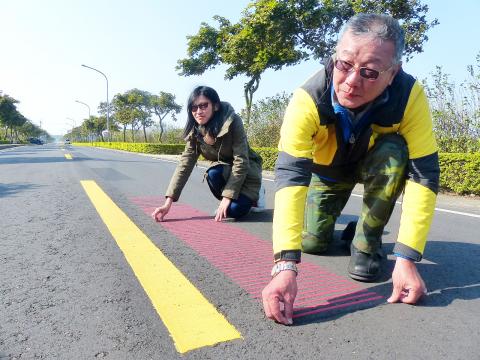The nation’s first “musical road” was unveiled in Kinmen’s Dinglin Road (頂林路), where cars driving at 50kph play a tune generated by the vibrations between their wheels and the notches placed on the road, a team of researchers from National Quemoy University said.
First conceived in Denmark, musical roads aim to keep drivers awake and encourage them to drive under the speed limit, said Liao Yi-chun (廖翊君), a civil engineering student at the university.
The 85-meter-long section of road in Kinmen is an improved version of an experimental project by the university, researchers said, adding that the new section was paved on the same stretch of Dinglin Road to replace the original patch paved two months ago, which was eroded by rain.

Photo: Wu Cheng-ting, Taipei Times
The project was funded by the Ministry of Science and Technology, the researchers said.
The previous version of the road played a section from Beethoven’s ninth Symphony, while the new one plays a section from The Olive Tree, a Taiwanese song by Chyi Yu (齊豫), they said.
Some drivers were cited by the researchers as joking that they wonder whether drivers who are unaware of the design would be scared or delighted when driving over the road and hearing a song.
Conventional musical roads use grooves cut into the road surface to generate the desired tune, but the team in Kimen used household anti-slip strips to the same effect, without the need to permanently alter the existing road, said Shui Li-fu (水利夫), research team member and a civil engineering student at the university.
“The road in Kinmen is designed to keep drivers awake with music while giving an audible warning to drivers who exceeded the speed limit by making discordant and high-pitched sounds,” Shui said.
While the Ministry of Science and Technology’s funding only covered the cost of building a short stretch of road that plays eight notes, the team hopes that the Kinmen County Government would allocate a budget for a full installation, the researchers said, adding that they might change the tune to the Republic of China anthem if they receive funding.

Taiwan is to commence mass production of the Tien Kung (天弓, “Sky Bow”) III, IV and V missiles by the second quarter of this year if the legislature approves the government’s NT$1.25 trillion (US$39.78 billion) special defense budget, an official said yesterday. Commenting on condition of anonymity, a defense official with knowledge of the matter said that the advanced systems are expected to provide crucial capabilities against ballistic and cruise missiles for the proposed “T-Dome,” an advanced, multi-layered air defense network. The Tien Kung III is an air defense missile with a maximum interception altitude of 35km. The Tien Kung IV and V

The disruption of 941 flights in and out of Taiwan due to China’s large-scale military exercises was no accident, but rather the result of a “quasi-blockade” used to simulate creating the air and sea routes needed for an amphibious landing, a military expert said. The disruptions occurred on Tuesday and lasted about 10 hours as China conducted live-fire drills in the Taiwan Strait. The Civil Aviation Administration (CAA) said the exercises affected 857 international flights and 84 domestic flights, affecting more than 100,000 travelers. Su Tzu-yun (蘇紫雲), a research fellow at the government-sponsored Institute for National Defense and Security Research, said the air

Taiwan lacks effective and cost-efficient armaments to intercept rockets, making the planned “T-Dome” interception system necessary, two experts said on Tuesday. The concerns were raised after China’s military fired two waves of rockets during live-fire drills around Taiwan on Tuesday, part of two-day exercises code-named “Justice Mission 2025.” The first wave involved 17 rockets launched at 9am from Pingtan in China’s Fujian Province, according to Lieutenant General Hsieh Jih-sheng (謝日升) of the Office of the Deputy Chief of the General Staff for Intelligence at the Ministry of National Defense. Those rockets landed 70 nautical miles (129.6km) northeast of Keelung without flying over Taiwan,

A strong continental cold air mass is to bring pollutants to Taiwan from tomorrow, the Ministry of Environment said today, as it issued an “orange” air quality alert for most of the country. All of Taiwan except for Hualien and Taitung counties is to be under an “orange” air quality alert tomorrow, indicating air quality that is unhealthy for sensitive groups. In China, areas from Shandong to Shanghai have been enveloped in haze since Saturday, the ministry said in a news release. Yesterday, hourly concentrations of PM2.5 in these areas ranged from 65 to 160 micrograms per cubic meter (mg/m³), and pollutants were